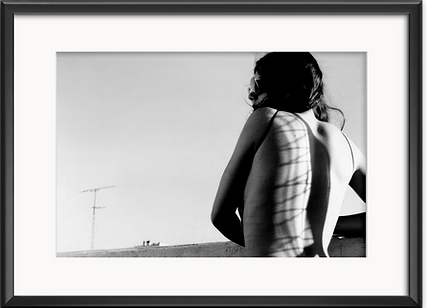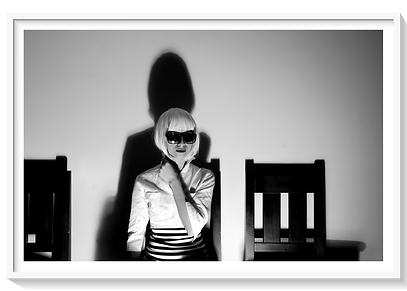
self portrait - My other me and you

series in conjunction with the artist Clara

His death left the work incomplete


Much of Mariano Rodríguez's work has been acquired by both national and international collectors. His photographs are part of the collections at the Aella Image Center in Paris, France; the Ibero-American Photographic Library of Cuba in Havana; and the Los Lavaderos Image Center in Tenerife, Spain. He has participated in technical assistance workshops for artists and art teachers, led by renowned photographer Elda Harrington and organized by the Federal Investment Council. His works have been featured in photography catalogs and books, most notably in the book Nudes Around the World edited by Peter Delius and Jacek Slaski, published by Bruckmann Verlag, Munich, which featured the artist's photo on the cover.
The Brutal Expression of the painter
Rodríguez's aesthetic has inspired art critics, including the Spanish critic Javier Cabrera, who wrote: "The Argentine Mariano Rodríguez evokes converging perspectives centered on the portrait, with a subtlety that invites contemplation of equidistant points on the same theme. In Rodríguez's work, the subjects invade the lens to assert their uniqueness. 'Enlightened' characters take center stage and affirm: 'because I stand out from the rest, I am the same as my tribe, because I am…'."

As of today, Mariano Rodríguez has not produced any new photographic or audiovisual material. The author himself stated in an interview for the art magazine IMMAGO MAGAZINE that he had destroyed all his work, including printed material, digital files, and negatives. Furthermore, he decided to distance himself from the artistic medium, arguing that contemporary art had acquired an absurd character, reduced to the degree of disgust it can provoke in the viewer.


The Aella Festival Paris is dedicated to promoting Latin American photography and film in Paris. In this report, we visit the events that took place from October 12 to 28, 2007, at the Bassin de la Villette, Promenade Simone Signoret, in the 19th arrondissement of Paris.
1999 - Casa de la Cultura, Paraná, Entre Ríos - 'Water Awakens the Creation'
2000 - Casa de la Cultura Santa Fe - 'Fotogramas'
2000 - Segura Fine Art Gallery in Paraná, Entre Ríos - 'Documentary'
2000 - Segura Fine Art Gallery in Paraná, Entre Ríos - 'Dual'
2000 - Museum of the City of Victoria, Entre Ríos - 'Group Exhibition'
2001 - Segura Fine Art Gallery in Paraná, Entre Ríos - 'Intimate'
2004 - La Hendija, Paraná, Entre Ríos - Erotic Film Festival - 'Girl'
2006 - Festival of Light - Buenos Aires - 'She'
2007 - Photo Aella Latin Paris - Paris, France - Cristina Castellano Selection
2007 - "Mujer", Exposición Internacional de Fotografía. Galería de Arte Plaza San Francisco, Santiago, Chile.
2008 - II International Festival of Photography - Paraná, Argentina - Shows Featuring 11 Photographers from Around the World
2009 - Tenerife, Spain - Los Lavaderos - 'The Others in Our Portrait,' Curated by Javier Cabrera
2010 - Juan L. Ortiz - Paraná, Entre Ríos - 'El Ensayo' Series Inspired by 'The Dancers' of French Impressionist Edgar Degas. Audiovisual Format
2010 - Roberto Guidotti Photo Gallery - Santa Fe - 'A VI Argentine Photographers' Collective Exhibition - Photographers Around the Country

THE OTHERS IN OUR PORTRAIT
Series commissioned by art critic Javier Cabrera, Tenerife, Spain.
Exhibition / Sala de Arte Los Lavaderos / Eduardo Chevilly,
Santa Cruz de Tenerife, Tenerife, Spain.
July 31, 2009 - August 21, 2009
Curated by: Javier Cabrera
Organized by: Sala de Arte Los Lavaderos
includes works by Javier Betancor, Vicky Delgado, Rosario Heer, Carla Poticella, Mariano Rodriguez, Gabriela Camerotti Bertao, Andrea de Valentim, Fernando Sendra, Solange Pastorino, José Pilone, and Suci Viera.
The Modern Conception of Art: Autonomy, Nihilism, and the Pursuit of Purity
Extract from interview Imago Mágazine, 2009


Modernity has significantly transformed the concept that defines a work of art, altering both the role of the artist and the purpose of the artistic work. In contemporary art, the artist is seen as an autonomous entity, operating in absolute creative isolation, detached from external pressures—be they social, political, or even historical. This isolation can be considered necessary for the creation of a work that arises as a product of itself, stripped of interpretations that could contaminate its essence. In the modern context, the artist is no longer simply a creator of images or a craftsman, but a figure existing in a state of absolute autonomy. This implies a radical independence from external influences, allowing the artist to operate from a creative void, which turns the work into a direct expression of their individuality.

In the modern context, the artist is no longer simply a creator of images or a craftsman, but a figure existing in a state of absolute autonomy. This implies a radical independence from external influences, allowing the artist to operate from a creative void, which turns the work into a direct expression of their individuality. The notion of the "artist as an island"—a concept developed by critics like Achille Bonito Oliva—is fundamental to understanding this conception. The artist, isolated within themselves, establishes their own rules and languages, building a work that responds to no imperative beyond their own vision.


However, this path towards purity is not synonymous with emotional clarity or simplicity. Rather, the modern artist finds themselves immersed in profound uncertainty, which makes them a nihilist, being aware that in their search for authenticity, they have destroyed the matrix of their own motivation. This paradox, in which the pursuit of "pure" art leads to the annihilation of the foundations that once inspired it, is an important feature of contemporary art. The break that the artist generates with history and tradition is not without consequences. By destroying the matrix of their own cause, they are left immersed in paralyzing uncertainty. In the search for authenticity and originality, the modern artist realizes that all forms of expression lose their meaning, they fade away. This nihilistic condition, far from being liberating, is a burden that overwhelms the creator, leaving them in a state of existential anguish. In this context, the work of art can be seen both as a cry of despair and as an attempt to find a new anchor point in a world devoid of certainties.




With the supposed liberation from artistic canons, art causes a rupture with tradition and history. In its pursuit of the "pure" or the "simple," the modern artist conceives representation not as a means to preserve or communicate the past, but as a tool to destroy historical consciousness. The work becomes an act of rebellion against the weight of the past, an effort to create something untainted by existing references throughout time. This rejection of history and tradition is, in many ways, an attempt to free art from the narratives that have dictated what should be meaningful or valuable, a work of art or an absurdity.



The concept of purity in modern art does not necessarily imply simplicity, in terms of technique or execution. Nowadays, a work can be defined as an objet trouvé, loaded with humor, that can convey nothing but dread, and its "conceptual value" is relevant only to a realm excessively dominated by labels. Therefore, the work becomes an ordinary object that only context and intention can turn into an artistic piece. It is the reflection of a mental disorder that modernity interprets as an autonomous, isolated, and nihilistic figure struggling to create in a world empty of meanings. This search for purity, although liberating in some sense, also brings profound anguish, as it involves the destruction of the foundations upon which artistic motivation has been built. The resulting work is a testimony to this struggle, an expression of the tension between autonomy and emptiness, between purity and despair.
©All works belong to Mariano E. Rodríguez


